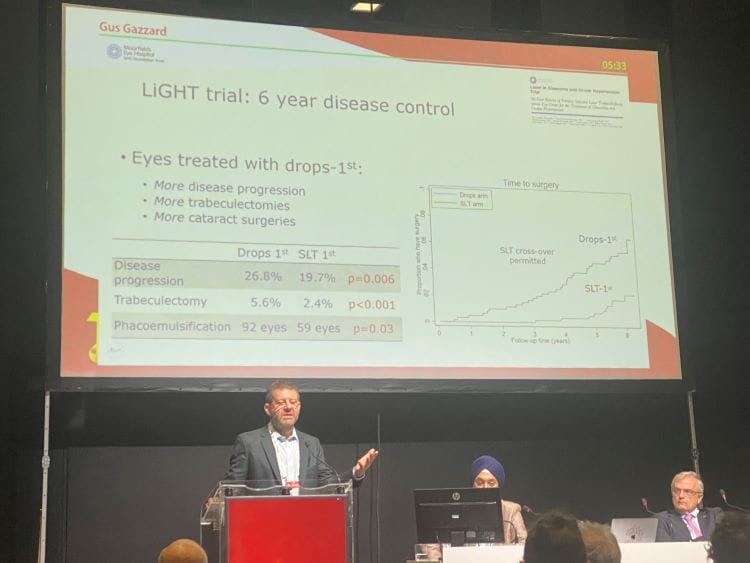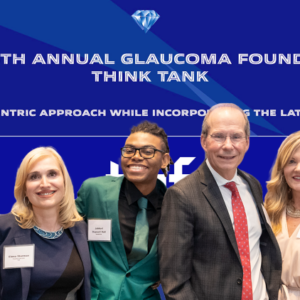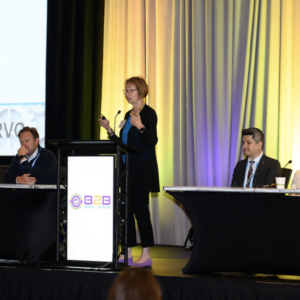July 26, 2023
In late June, I had the opportunity to attend and present at the 2023 World Glaucoma Congress (WGC), held in Rome. The WGC is the biennial conference of the World Glaucoma Association, a group of 91 regional and country glaucoma societies. The Association of International Glaucoma Societies (AIGS) was formed more than 20 years ago as an umbrella association for the world’s glaucoma societies. Three individuals, Erik Greve, Roger Hitchings, and Robert Weinreb were the originators who realized that in order to reduce blindness due to glaucoma, everyone had to work together. I was asked if optometry had a glaucoma society, and when I answered that we did not, they helped form the Optometric Glaucoma Society, which became one of the original member societies. The AIGS soon changed its name to the World Glaucoma Association (WGA), with the first WGC held in Vienna in 2005. The WGC is held every other year, with the next conference scheduled to take place June 25-28, 2025, in Honolulu.
Location Determines Treatment Options
The WGC is an incredible meeting for a host of reasons. The world’s glaucoma experts are in attendance, allowing one to learn about many topics, meet colleagues from around the world, and learn how glaucoma is diagnosed and treated globally. Surprisingly, there are differences based upon where one is located. Some countries have access to medications not available in the United States, while others have few resources. In some, angle closure is a significant problem, while in others secondary glaucoma prevails. Surgical options also vary globally with some devices or instruments not available due to the ways regulatory agencies work or commercial opportunities.
As I walked through the exhibit hall floor, there was little mention of medications. Imagine walking through the expos or academy and not seeing one banner related to an eye drop. Perhaps, this is the future. Booths were filled with new surgical instruments, stents, and diagnostic devices. There was more booth space given to neuroprotective supplements than medications, which was hard to fathom. AbbVie was present with a large booth, but the name Allergan was nowhere to be seen. Walking around the exhibit floor, there was a sense that this is where glaucoma care is moving.
WGC Sees the Value of Optometry
The WGC embraced optometry from the organization’s inception, recognizing optometry’s role in eye care and its importance if we are to reduce the burden of blindness related to glaucoma. Unlike some ophthalmic meetings that do not allow optometrists or restrict their attendance, the WGC welcomes ODs. There are many courses with different levels of sophistication so that most optometrists will find one that meets their level of expertise. Member societies present a one-hour course as part of the meeting with the Optometric Glaucoma Society presenting one on Controversies in Glaucoma.
Michael Chaglasian was the co-chair with me for this symposium. The WGC offers different types of lectures: plenary sessions, symposiums, rapid fire courses, traditional one-hour courses, and poster sessions. There were more than 900 posters to browse over the four-day meeting, and included were specific times to meet with the poster’s authors. One symposium titled, “How to Reorganize Glaucoma Treatment Strategies,” summed up the evolving nature of therapy. Topics included: who really needs a MIGS device, are we over-treating, are laser treatments our best shot, and discussions on how to monitor and when to go for re-treatment. Other topics included topical therapy: the good and the bad, sustained drug delivery: will it make a difference, what is the best first-line option for ocular hypertension, for early glaucoma, and for advanced glaucoma.
In the rapid-fire session, R Singh and colleagues presented “Machine Learning Derived Visual Field Patterns are Associated with Glaucoma Polygenic Risk Scores in the Ocular Hypertension Treatment Study.” They found that high genetic risk for primary open-angle glaucoma was associated with superior visual field loss found within two years of detectable disease. They could not find genetic reasons for paracentral and nasal loss patterns. In another rapid-fire session, Chris Leung and colleagues discussed, “A Deep Learning Approach to Predict Visual Field Using Retinal Nerve Fiber Layer Optical Texture Analysis Maps Was Able to Train a Deep Learning Model to Detect Loss Using the ROTA Maps.” Retinal nerve fiber layer (RNFL) optical texture analysis is a new method to assess the RNFL and has great diagnostic potential, which this session described. The abstract book from the WGC is available at https://worldglaucomacongress.org/abstracts/abstract-book/.
The WGA produces one publication quarterly, the International Glaucoma Review (IGR), edited by Robert Weinreb. This journal reviews recent glaucoma publications with a short abstract provided for each paper followed by expert commentary. Sections cover topics including: artificial intelligence, epidemiology, screening and detection, basic science, clinical examination methods, telemedicine, risk factors to laser, and medical and surgical treatment. It is a journal well worth reading.
The Journal of Glaucoma is the journal of the WGA. Also, the WGA has four online courses available: Managing Complications of Post-Surgical Hypotony, Primary Angle Closure Suspect, Management of Primary Angle Closure Glaucoma, and Approach to Exfoliation Syndrome and Exfoliation Glaucoma. Click the links for more information about the World Glaucoma Association, and the Optometric Glaucoma Society.
The World Glaucoma Congress is an exceptional event that has only been held once in the United States (Boston 2009). The 2025 meeting in Hawaii will be an opportunity to meet optometrists, ophthalmologists, and scientists from around the world who have a passion for glaucoma. I look forward to seeing many optometrists there.





